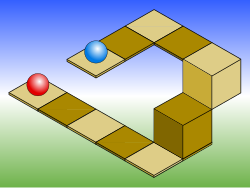Isometric projection

| Part of a series on |
Graphical projection |
|---|
 |
Isometric projection is a method for visually representing three-dimensional objects in two dimensions in technical and engineering drawings. It is an axonometric projection in which the three coordinate axes appear equally foreshortened and the angle between any two of them is 120 degrees.
Overview

The term "isometric" comes from the
An isometric view of an object can be obtained by choosing the viewing direction such that the angles between the projections of the x, y, and z
In a similar way, an isometric view can be obtained in a 3D scene. Starting with the camera aligned parallel to the floor and aligned to the coordinate axes, it is first rotated horizontally (around the vertical axis) by ±45°, then 35.264° around the horizontal axis.
Another way isometric projection can be visualized is by considering a view within a cubical room starting in an upper corner and looking towards the opposite, lower corner. The x-axis extends diagonally down and right, the y-axis extends diagonally down and left, and the z-axis is straight up. Depth is also shown by height on the image. Lines drawn along the axes are at 120° to one another.
In all these cases, as with all
The term "isometric" is often mistakenly used to refer to axonometric projections, generally. There are, however, actually three types of axonometric projections: isometric,
Rotation angles
From the two angles needed for an isometric projection, the value of the second may seem counterintuitive and deserves some further explanation. Let's first imagine a cube with sides of length 2, and its center at the axis origin, which means all its faces intersect the axes at a distance of 1 from the origin. We can calculate the length of the line from its center to the middle of any edge as √2 using
Mathematics
There are eight different orientations to obtain an isometric view, depending into which octant the viewer looks. The isometric transform from a point ax,y,z in 3D space to a point bx,y in 2D space looking into the first octant can be written mathematically with rotation matrices as:
where α = arcsin(tan 30°) ≈ 35.264° and β = 45°. As explained above, this is a rotation around the vertical (here y) axis by β, followed by a rotation around the horizontal (here x) axis by α. This is then followed by an orthographic projection to the xy-plane:
The other 7 possibilities are obtained by either rotating to the opposite sides or not, and then inverting the view direction or not.[1]
History and limitations
First formalized by Professor
As with all types of
Usage in video games and pixel art
Isometric video game graphics are graphics employed in
Once common, isometric projection became less so with the advent of more powerful
See also
- Graphical projection
References
- S2CID 708008.
- ^ William Farish (1822) "On Isometrical Perspective". In: Cambridge Philosophical Transactions. 1 (1822).
- ISBN 0-409-90035-4. p.243.
- ^ Charles Edmund Moorhouse (1974). Visual messages: graphic communication for senior students.
- ^ J. Krikke (1996). "A Chinese perspective for cyberspace? Archived 2016-02-05 at the Wayback Machine". In: International Institute for Asian Studies Newsletter, 9, Summer 1996.
- ^ a b Jan Krikke (2000). "Axonometry: a matter of perspective". In: Computer Graphics and Applications, IEEE Jul/Aug 2000. Vol 20 (4), pp. 7–11.
- ^ a b Signor, Jeremy (2014-12-19). "Retronauts: The Continued Relevance of Isometric Games". usgamer.net. Gamer Network. Archived from the original on 2022-09-25. Retrieved 2017-04-01.
- ^ Vas, Gergo (2013-03-18). "The Best-Looking Isometric Games". kotaku.com. Gizmodo Media Group. Archived from the original on 2021-10-10. Retrieved 2017-04-01.








